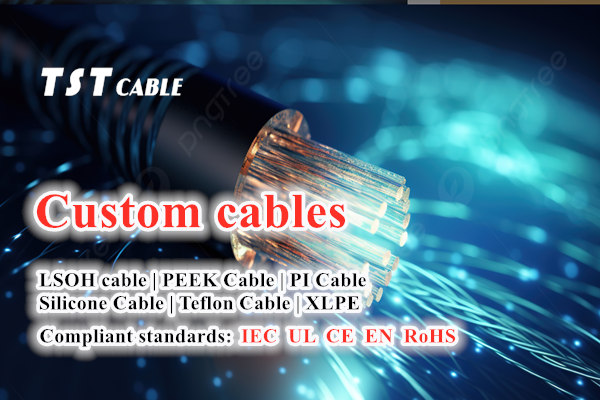Flexible silicone rubber cables are widely used in various industrial fields due to their excellent electrical properties, mechanical flexibility and environmental resistance. SIAF cable, SIAF-GL cable, SIHF cable and SIHF-P cable are several common silicone rubber cable models, each of which has specific application scenarios and technical characteristics. TST CABLES will introduce the types, characteristics and applications of flexible silicone rubber cables.

1. SIAF cable (Silicone Insulated Armored Flexible Cable)
Definition: SIAF is a flexible cable with silicone rubber insulation and metal armor layer.
Structure:
Conductor: braided with multiple strands of fine copper wire, providing good flexibility and high current carrying capacity.
Insulation layer: silicone rubber insulation, with excellent heat resistance, cold resistance and anti-aging properties.
Armor layer: galvanized steel belt or steel wire armor, enhanced mechanical protection to prevent external physical damage.
Outer sheath: usually PVC or other wear-resistant materials, protecting the internal structure from chemical corrosion and ultraviolet radiation.
Application: suitable for occasions requiring high mechanical strength and good electrical insulation performance, such as automation equipment, robotic systems, etc.
2. SIAF-GL cable (Silicone Insulated Armored Flexible Cable with Gland)
Definition: SIAF-GL is an improved cable with a gland design added to SIAF.
Features:
Gland: The provided gland ensures waterproof and dustproof effects at the cable terminal, which is particularly suitable for outdoor installation or use in humid environments.
Application: Commonly used in applications with strict requirements on sealing, such as chemical plants, sewage treatment facilities, etc.
3. SIHF cable (Silicone Insulated Heat Resistant Flexible Cable)
Definition: SIHF refers to silicone rubber flexible cables specially designed for high temperature environments.
Structure:
Conductor: Also composed of multiple strands of fine copper wire to ensure sufficient flexibility.
Insulation layer: Special silicone rubber insulation material that can maintain stable electrical properties within extreme temperature ranges.
Outer sheath: May use more high temperature resistant materials, such as fluoroplastics (FEP), to meet the requirements of higher working temperatures.
Application: Mainly used in high temperature working areas, such as steel plants, glass manufacturing workshops, ovens, etc.
4. SIHF-P cable (Silicone Insulated Heat Resistant Flexible Cable with Protection)
Definition: SIHF-P is a version of SIHF with additional protection measures to improve its durability and safety in harsh conditions.
Features:
Additional protection: may include but is not limited to thicker sheath, double shielding, fire-resistant coating, etc., depending on the manufacturer’s design.
Application: Suitable for mission-critical applications in extreme environments, such as nuclear power plants, aerospace equipment, and other places with extremely high requirements for reliability and safety.
Common features
Silicone rubber insulation: All of the above models use silicone rubber as the main insulation material, which has excellent high and low temperature resistance (generally normal operation between -60°C and +200°C), good elasticity and weather resistance.
Highly flexible: Due to the use of multiple strands of fine copper wire as conductors and the good flexibility of silicone rubber itself, these cables are very suitable for occasions with frequent bending or movement.
Chemical corrosion resistance: The silicone rubber insulation layer can resist the erosion of a variety of chemicals, including acid and alkali solutions, solvents, etc., extending the service life of the cable.
Application Scenarios
These cable types are widely used in the following areas:
Industrial Automation: Robotic arms, conveyor systems, control panel connections, etc.
High temperature environments: Internal wiring of high temperature equipment such as furnaces, ovens, dryers, etc.
Harsh conditions: Areas that require special properties such as oil resistance, water resistance, and salt spray resistance, such as the petrochemical industry, mining, and marine engineering.
Medical equipment: Surgical instruments, diagnostic instruments, and other occasions that have strict requirements on cleanliness and biocompatibility.
Application Case Analysis
1. Industrial Automation and Robotics
Challenges: In industrial automation environments, cables need to withstand frequent bending, twisting, and stretching, and adapt to different temperature changes.
Solutions:
SIAF and SIAF-GL: These two types of cables are ideal for their high flexibility and mechanical strength. The sealed joint design of SIAF-GL is particularly suitable for applications that require waterproof and dustproof, such as automated production lines in the food processing or pharmaceutical industries.
2. High temperature working areas
Challenges: In high temperature environments such as steel mills and glass manufacturing workshops, ordinary cables are prone to failure due to overheating.
Solution:
SIHF and SIHF-P: Designed for high-temperature environments, they can withstand extreme temperatures without affecting electrical performance. SIHF-P adds an extra layer of protection for more demanding working conditions, such as internal wiring in nuclear power plants.
3. Petrochemical Industry
Challenge: There are a large number of chemicals and potential explosion risks, requiring cables to be corrosion-resistant and explosion-proof.
Solution:
SIAF and SIHF: Silicone rubber insulation has good chemical resistance, and products with metal armor can be selected to enhance resistance to mechanical damage.
4. Medical Equipment
Challenge: Cleanliness and biocompatibility are strictly required in medical environments, and cables must be easy to clean and not release harmful substances.
Solution:
SIAF: Its silicone rubber insulation layer is smooth, easy to clean, and does not absorb dust or microorganisms, making it ideal for connecting surgical instruments and diagnostic instruments.
Installation Notes
1. Path Planning:
Ensure that the cable path is away from heat sources, sharp objects, and other factors that may cause physical damage.
Try to minimize the bending radius of the cable to avoid excessive stretching or compression.
2. Fixing method:
Use appropriate clamps and brackets to fix the cable to prevent wear caused by vibration.
For parts that move frequently, consider using spring tubes or other flexible protective devices.
3. Terminal processing:
Properly strip and terminate the wires according to the instructions provided by the manufacturer to ensure good electrical contact.
If using sealed connectors (such as SIAF-GL), be sure to strictly follow the instructions to ensure the sealing effect.
4. Marking and identification:
Clearly mark the function and direction of each cable in the entire system to facilitate later maintenance.
Maintenance recommendations
1. Regular inspection:
Establish a regular inspection system, especially for cables exposed to the outside or in harsh environments, to detect and deal with potential problems in a timely manner.
Pay attention to whether the surface of the cable is damaged or aging, and replace it if necessary.
2. Cleaning and maintenance:
Develop a corresponding cleaning plan according to the application environment to keep the cable surface clean and free of stains.
Wipe with a mild detergent and soft cloth, and avoid using solvents or hard brushes to damage the insulation layer.
3. Record keeping:
Record the results of each inspection and track the development trend of potential problems so that preventive measures can be taken in advance.
Maintain complete installation records and technical documentation to facilitate subsequent maintenance and troubleshooting.
Technical details and industry standards
Certification and compliance: All products must comply with relevant international and national standards, such as IEC, UL, CE, etc., to ensure their quality and safety.
Testing and verification: Through a series of rigorous tests, including voltage resistance test, insulation resistance test, continuity test, etc., to ensure that the electrical performance of the cable meets the standards.
Environmental adaptability: Simulate extreme temperature, humidity, vibration and other factors under actual working conditions, conduct aging tests, impact tests, etc., to evaluate the long-term reliability of the cable.
Future development of silicone rubber cable technology
With the advancement of new materials science and technology, silicone rubber cables are also constantly innovating:
High-performance composite materials: Research and develop new composite materials to further improve the comprehensive performance of cables, such as higher current carrying capacity, better wear resistance, etc.
Intelligent monitoring system: Integrated sensors and monitoring devices, real-time tracking of cable status, timely warning of potential problems, and improving system safety and efficiency.
Environmentally friendly materials: Explore the use of recyclable or biodegradable materials to reduce environmental impact and promote sustainable development.
Choosing the right silicone rubber cable model is essential to ensure the safe and stable operation of the system. According to the needs of specific application scenarios, taking into full consideration factors such as temperature range, mechanical stress, chemical environment, etc., TST CABLES engineers can help you select the most suitable product. If you have more specific needs or want to know more information, please send us an email to communicate and provide more detailed information such as product application scenarios. TST CABLES will wholeheartedly provide you with help and support.
Also available in:
English



